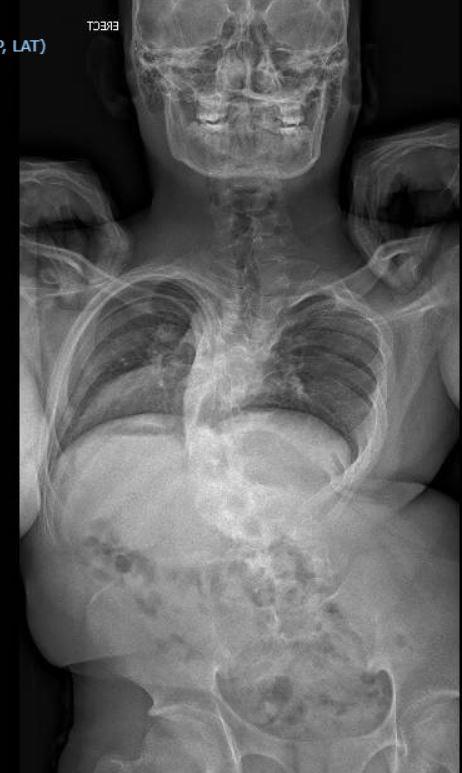Daisy Villena never expected a news report would change her only child’s life.
Her son Chinno was suffering from severe congenital kyphoscoliosis. All of the vertebrae in his spine were fused together, leaving him with a misshapen back and shoulders. Inside his torso, important organs like his heart and intestines struggled to function, and he couldn’t participate in most physical activities. He was self-conscious and shy, hiding the spinal deformity with a backpack.
Villena had sought care for Chinno in their native Philippines for years to no avail. He had surgery at 7 years old to attempt to put rods in his spine but surgeons found his bones were too soft and couldn’t support the titanium pieces. Then, doctors recommended a brace but what she said was a “lack of attention and resources from the care team” meant Villena and her son “never had the opportunity to pursue that route.”
In 2019, Villena saw a CNN story about a teen whose extreme scoliosis had been treated by New York City surgeon Dr. Lawrence Lenke, co-director of the Och Spine Hospital at NewYork-Presbyterian. Frustrated by her now 10-year-old son’s struggle to receive care, Villena resolved to move to the United States and seek treatment with Lenke.
Daisy Villena
“With every visit with the doctors in the Philippines, I realized that his case would never be treated or addressed properly,” said Villena. “I prayed and set myself a goal to move to the U.S. to find experts who could help correct his spine and find new hope.”
What is congenital kyphoscoliosis?
Scoliosis and kyphosis are both conditions that cause the spine to curve, with kyphosis curving the spine from front to back and scoliosis curving it from side to side. Kyphoscoliosis happens when a person has both conditions at once, said Dr. Joshua Bakhsheshian, a neurosurgeon at the Mayo Clinic who focuses on spinal deformities and was not involved in Chinno’s care.
“It’s one of the most severe types of deformity,” said Bakhsheshian. “It’s also one of the most difficult ones to treat with a good outcome.”
In addition to the rounding or hunching of the back that Chinno experienced, people with kyphoscoliosis may have “severely decreased” lung volume and “severe impacts” to their overall cardiovascular health, Bakhsheshian said. The condition can also compromise a person’s spinal cord.
NewYork-Presbyterian’s Morgan Stanley Children’s Hospital
All people have some kyphosis, said Dr. Juan C. Rodriguez-Olaverri, the director of pediatric spinal deformity surgery and early onset scoliosis at Hassenfeld Children’s Hospital at NYU Langone, who was also not involved in Chinno’s care. The average person has between 25 and 45 degrees of kyphosis. Chinno had 140-degree kyphosis, which Rodriguez-Olaverri described as an “extremely, extremely severe” form of the condition.
Traveling across the world for life-changing care
Villena knew that moving to the United States would be difficult, but years later, she saw an opportunity. Her workplace, a human relations department with a focus on recruiting for a government contracting company in the U.S., was opening an office in Florida. In 2023, she received a work visa, and the pair made the more than 9,000-mile move in 2023.
Chinno and Villena traveled to New York City to meet Lenke about six months later. Chinno, now 17, was experiencing even more complications from the kyphoscoliosis, and the severity of his condition could lead to more health problems, including trouble breathing if left untreated.
Lenke, who has been treating patients with spinal deformities for over 30 years, developed a three-stage treatment approach. First was a process called payload gravity traction, when a ring is pinned on the patient’s skull. Weight is slowly added to try to stretch the spine and prepare the spine and spinal cord for future operations.
After a month, Chinno underwent his first reconstructive spinal surgery. The second followed two weeks later. Each operation took about 10 hours, Lenke said, and the procedures unfused Chinno’s vertebrae and straightened his spine. Seeing her son stand straight brought Villena to tears, she said.
“I was really crying,” Villena said. “It was really fulfilling to see him treated.”
Daisy Villena
The surgeries were followed by several months of physical therapy and rehabilitation, where Chinno relearned how to walk, stand and more. Now, Villena and Chinno are back in Florida, where Chinno has overcome his shyness, is making friends with his classmates and participating in sports he’d always dreamed of playing. Lenke said that Chinno should have no further spinal problems and will be able to live a largely normal life.
“I’ve done this for a long time. I’ve taken care of thousands of patients, and he really just is unique,” Lenke said of Chinno. “I really credit (Villena) for the fortitude and ambition to get him to a center like ours that specializes in this type of complex deformity surgery. It wasn’t an easy thing for her to do. And so I really give them both credit for getting the means and the will to get Chinno to us and for having a great attitude during all this because it’s tough. It’s not an easy road. But they never skipped a beat.”




Leave a Reply